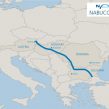
Nabucco Countries’ Governments Appeal to EU for Support of the Project
Publication: Eurasia Daily Monitor Volume: 10 Issue: 79
By:

The governments of transit countries in the Nabucco-West project—Austria, Hungary, Romania and Bulgaria—have appealed to the European Union’s top executive authorities to support the selection of this pipeline route by the Shah Deniz gas producers in Azerbaijan.
The producers’ consortium intends to select either the Nabucco-West route to Central Europe, or the rival Greece-Albania-Adriatic seabed-Italy route (Trans-Adriatic Pipeline—TAP) for transportation of Caspian gas to Europe. Both of these pipeline projects exist thanks to the Azerbaijan-led Trans-Anatolia Pipeline (TANAP) project, which will feed Caspian gas via Turkey into either Nabucco-West or TAP. These two rival projects have submitted their bids to the Shah Deniz producers’ consortium at the end of March. The gas producers are expected to announce the pipeline selection decision in June.
The four Nabucco countries’ letter, signed by their ministers of foreign affairs, stops elegantly short of mentioning the rival TAP project. Rather, their appeal to the EU focuses on the strategic rationale of the Nabucco project and the European Commission’s own criteria, which had led the Commission to endorse Nabucco over rival projects (including TAP) in previous years. More recently, however, the Commission—as well as the Barack Obama administration in Washington—have positioned themselves equidistantly between Nabucco-West and TAP. In this sense, the Nabucco countries’ letter amounts to a reminder of strategic objectives shared with the EU and retaining their validity.
The ministers’ letter includes the following salient points (www.nabucco.pipeline.com, April 24):
1. EU energy policy needs more coherence and coordination between the Union and its member states, it should be guided by solidarity and strategic cooperation.
2. New energy suppliers [i.e., Azerbaijan] should be engaged not only in a commercial dimension, but also in the framework of their wider political relations with the EU by building partnerships with them.
3. The Nabucco project embodies the EU’s own criteria and priorities for achieving security of energy supplies, since this pipeline would bring new supplies to countries that need them most.
4. This project connects new, verified gas sources and future potential large providers, through a pipeline corridor with scalable capacity, with the geographical center of the European gas market.
5. Nabucco answers best to the European Commission’s priority goal of ensuring supply diversification in this part of the EU.
6. The Nabucco project would to a significant degree cover the transited region’s needs for interconnecting pipelines.
Emphatically stated, “[I]t is in the EU’s wider interest that these views are acknowledged, and taken stock of, by the European Commission, the External Action Service and the other relevant structures. This would only be consistent with its previous statements and views.”
These points clearly allude to Nabucco West’s comparative advantages (as seen from an EU perspective) over TAP, to wit:
• strategic impact on the targeted markets in terms of supply diversification;
• prioritization of those markets in line with diversification urgencies; pipeline scalability to ensure strategic volumes from potential new providers (e.g., Turkmenistan);
• access to the Central European Gas Hub at Baumgarten near Vienna; and
• Nabucco-West’s added value, as backbone for existing and planned interconnector pipelines between the countries along this route.
Conversely, by emphasizing those advantages, the ministers’ letter indirectly points out where the rival TAP project falls short of the EU’s strategic objectives. The Commission had designed the Southern Gas Corridor in pursuit of supply security and diversification goals.
Those are not TAP’s priorities. TAP targets Italy as its main market. Italy, however, is fully saturated and highly diversified with gas supplies by overland pipeline from Russia (via Ukraine-Slovakia-Austria to Italy), seabed pipelines from North Africa, and tanker-delivered liquefied natural gas (LNG) from African and Middle Eastern suppliers. Moreover, Italy is massively building new LNG-reception terminals, apparently seeking to become itself a northbound transit corridor into continental Europe.
The TAP project seems to be mapping out its market destinations reflecting in part Italian transit ambitions. In submitting its final bid to the Shah Deniz gas producers, the TAP pipeline consortium touted its potential to reach via Italy as far as “Northern Europe” with Caspian gas in the future, “as and when more volumes become available” (TAP press release, March 28). A follow-up TAP communication underscores opportunities to deliver Caspian gas volumes via Italy to Switzerland, Germany, France, the United Kingdom and Austria, already at the first stage of TAP’s operation, if this project is selected (TAP press release, April 10).
TAP’s ownership structure has all along been predominantly non-EU (42.5 percent Norwegian, another 42.5 percent Swiss, 15 percent German, and a proposed “strategic” storage site in Albania). But it defined EU member country Italy as TAP’s main market (with Greece and Albania to receive minor portions from the gas flow en route to Italy).
For several years, TAP proposed to “open” the Southern Gas Corridor ahead of the Nabucco project, the implication being that this would merely be a sequencing decision (allowing both projects to proceed in this sequence), not an either-or decision. This could be read as meaning that Nabucco would be postponed, but not killed, if TAP gained priority access to Shah Deniz gas.
However, TAP advertises a possible capacity scale-up from 10 bcm to 20 bcm per year (through additional compressor power, not parallel pipeline strings). It plans to deliver future volumes of Caspian gas (“as and when more volumes become available”—see above) to Western and even Northern Europe, where the energy mix as well as gas supplies are well-diversified, and LNG is accessible. With such planning, TAP would continually direct Caspian gas away from Nabucco-West’s participant countries in Southeastern and Central Europe, even as those countries remain heavily dependent on Russian gas, and lack access to LNG.
TAP may well be an attractive corporate business project in its own right. But it does not reflect the strategic goals and priorities that had inspired the European Commission to design the Southern Gas Corridor.




